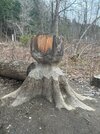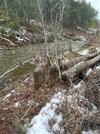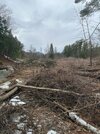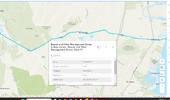Beaver Deceiver At Webb's Mill
- Thread starter Teegate
- Start date
You are using an out of date browser. It may not display this or other websites correctly.
You should upgrade or use an alternative browser.
You should upgrade or use an alternative browser.
Sort of related, but does anyone know what successional processes would create areas of bare sand for Schizaea and clubmoss gametophytes to establish? Fire in a dry year? I can see how limited flooding would be marginally helpful in retarding white-cedar growth, but if anything, it would lead to deposit of more organic matter, which doesn't seem helpful.
Schizaea and clubmoss is mosty found in damp areas also containing Sphagnum, so I'm not so sure going to bare sand is a good start for them.Sort of related, but does anyone know what successional processes would create areas of bare sand for Schizaea and clubmoss gametophytes to establish? Fire in a dry year? I can see how limited flooding would be marginally helpful in retarding white-cedar growth, but if anything, it would lead to deposit of more organic matter, which doesn't seem helpful.
My general experience is that fern and lycophyte gametophytes need at least a tiny patch of bare ground for the spore to germinate. I thought I remembered reading that you could once see gametophytes of S. pusilla in the open at Webbs Mill when the population was in better shape, but I can't find it right now. (It's probably a side note from one of Ted Gordon's trip reports in Bartonia, or maybe in the Swatzell & Kiss gametophyte literature.)
Curly grass is way more numerous than people think it is. The ones at Webb's Mill (at least the ones near the boardwalk) were small in comparison to others in the pines.My general experience is that fern and lycophyte gametophytes need at least a tiny patch of bare ground for the spore to germinate. I thought I remembered reading that you could once see gametophytes of S. pusilla in the open at Webbs Mill when the population was in better shape, but I can't find it right now. (It's probably a side note from one of Ted Gordon's trip reports in Bartonia, or maybe in the Swatzell & Kiss gametophyte literature.)
Do you have habitat on your property that's suitable?
The biggest population I've seen is also at a very accessible site, and on comparatively open dry ground (although I'm sure it gets wetter when the adjacent water level goes up). I looked through some photos I took on one of the savannas last year and some of them were on ground, albeit not bare ground (sand mixed with muck and sprinkled with downed needles), but some do appear to be coming straight out of the peat. I saw quite a few individuals sprinkled through the savanna once I had my search image and microhabitat dialed in, but never in large masses.
I don't have a place to grow it myself, but I know some one at a conservation organization who would like to try taking it all the way from spore to sporophyte some day. (The literature on spore->gametophyte, the fungal partner, etc., is pretty good, but I don't know if anyone has gotten it to sporophyte.) And I know someone in Ecuador who might have access to Andean material, which I am still not convinced is conspecific...
I don't have a place to grow it myself, but I know some one at a conservation organization who would like to try taking it all the way from spore to sporophyte some day. (The literature on spore->gametophyte, the fungal partner, etc., is pretty good, but I don't know if anyone has gotten it to sporophyte.) And I know someone in Ecuador who might have access to Andean material, which I am still not convinced is conspecific...
You speak like you have a background in the wild plant world. Would you care to expound on your background?The biggest population I've seen is also at a very accessible site, and on comparatively open dry ground (although I'm sure it gets wetter when the adjacent water level goes up). I looked through some photos I took on one of the savannas last year and some of them were on ground, albeit not bare ground (sand mixed with muck and sprinkled with downed needles), but some do appear to be coming straight out of the peat. I saw quite a few individuals sprinkled through the savanna once I had my search image and microhabitat dialed in, but never in large masses.
I don't have a place to grow it myself, but I know some one at a conservation organization who would like to try taking it all the way from spore to sporophyte some day. (The literature on spore->gametophyte, the fungal partner, etc., is pretty good, but I don't know if anyone has gotten it to sporophyte.) And I know someone in Ecuador who might have access to Andean material, which I am still not convinced is conspecific...
Longtime PBC member (I've met and/or been in the field with you, Russ, oji, Ted, Mark, Terry etc. at various times). My day job is in science and teaching generally, not botany, but I am often out in the field, and I do a certain amount of volunteer restoration work in my own country west of the Delaware. I have a particular interest in successional communities (my life seems to be bounded by pitch pine and scrub oak, some days) and I'm a semi-professional fern taxonomist.
(And PBC could use some more Pines trips on the docket, if you or any of the usual crew would care to lead one...)
(And PBC could use some more Pines trips on the docket, if you or any of the usual crew would care to lead one...)
Thank you for opening up. I've not been on a trip in 5 years or so. I used to consider leading trips into the pines, but I always discarded the idea thinking that people on the other side of the river have either seen it all, or would not care to be thrust that deep into the swamps and watersheds where I go. And now, with our changing climate, it can be pure hell out there, like it was yesterday on the Three-foot Branch in the plains. In fact, notice how the trips in the pines have dropped off to zero? It can't be fully explained by climate and same-o, same-o. There is likely some young members who would welcome it.Longtime PBC member (I've met and/or been in the field with you, Russ, oji, Ted, Mark, Terry etc. at various times). My day job is in science and teaching generally, not botany, but I am often out in the field, and I do a certain amount of volunteer restoration work in my own country west of the Delaware. I have a particular interest in successional communities (my life seems to be bounded by pitch pine and scrub oak, some days) and I'm a semi-professional fern taxonomist.
(And PBC could use some more Pines trips on the docket, if you or any of the usual crew would care to lead one...)
That's very interesting. I collect plants, and have most of the PL ferns in my collection. But I'm purely a generalist (but do favor grasses and sedges), and when I do encounter a fern I don't know, I pray the sori are intact and mature. That's rarely the case!I'm a semi-professional fern taxonomist.
When we have a very hot burn, or a bulldozed piece of ground, Mark and I often visit the location at least 2 years in a row, to see what comes up. It's fascinating to see things pop up unexpectedly, like; "what's that doing here"? And with the new carbon load in the ground, things grow to sizes we are unused to encountering. Mark is a premier PL botanist, he and I work in the field together often. We did a complete survey of the Lakehurst Navy base in 2021 and 2022. We had to collect two vouchers of each vascular species. He, I, and Dave Snyder came up with 777 different species.I have a particular interest in successional communities (my life seems to be bounded by pitch pine and scrub oak, some days) and I'm a semi-professional fern taxonomist.
I assume it's a combination of the loss of Ted's activity and the general disruption of COVID, which in my experience has knocked a lot of volunteer groups all galley-west just by throwing routines off the tracks. I was sort of expecting Mark and the other usual suspects to have put up a few trips; I was looking forward to standing in some sandy waste with him waving a graminoid in my face, saying "Do ya know what this is?"Thank you for opening up. I've not been on a trip in 5 years or so. I used to consider leading trips into the pines, but I always discarded the idea thinking that people on the other side of the river have either seen it all, or would not care to be thrust that deep into the swamps and watersheds where I go. And now, with our changing climate, it can be pure hell out there, like it was yesterday on the Three-foot Branch in the plains. In fact, notice how the trips in the pines have dropped off to zero? It can't be fully explained by climate and same-o, same-o. There is likely some young members who would welcome it.
PBC does seem to have a reasonably steady flux of new members, often horticulture and botany students, who probably haven't seen much of the Pines, so I think there would be interest. Certainly when I started with the club, adventures in the Pines were very memorable and probably helped make me a regular. One that stands out rather distinctly was Gerry Moore and Uli Lorimer taking us to Sherman Avenue Bog in Vineland...the day after a hard rain. It was well attended, too! Imagine 20 or so botanists wandering around in a cedar swamp in water gradually increasing to about thigh-deep. I remember standing on a fallen cedar moving items out of my lower pockets into upper compartments when it became clear just how wet I was going to get. Somehow we got separated into two groups in the swamp, and I swear Gerry had watermarks around his shoulders when we reunited, but maybe that was my imagination. Only disappointment was that we couldn't see the anticipated Schizaea without a snorkel. Did get some Massachusetts fern though, which is always nice.
You do have to warn people about adventurous conditions in the description, though, and to take enough water. I also remember the despairing feeling on another trip of running through my 2L of water just as Russ launched into a patient, methodical attack on a particularly obnoxious Gleason & Cronquist couplet differentiating the stellate hairs in Quercus (#22, for the bloody-minded). I think my brain shriveled by the time that was done. I carry a 3L water bladder now.
I've been on several of Gerry's trips. Sometimes he and I discuss abscence of, or new inclusions to, the Flora of Southern NJ via email. It tickles me how he sometimes leads in his sneakers and regular plants. He is a wealth of knowledge for sure, and his recent authorship of an overview of the Torrey Botanical Socienty's contribution to field work with a discussion on it's founding and founding members is a great read and well researched.I assume it's a combination of the loss of Ted's activity and the general disruption of COVID, which in my experience has knocked a lot of volunteer groups all galley-west just by throwing routines off the tracks. I was sort of expecting Mark and the other usual suspects to have put up a few trips; I was looking forward to standing in some sandy waste with him waving a graminoid in my face, saying "Do ya know what this is?"
PBC does seem to have a reasonably steady flux of new members, often horticulture and botany students, who probably haven't seen much of the Pines, so I think there would be interest. Certainly when I started with the club, adventures in the Pines were very memorable and probably helped make me a regular. One that stands out rather distinctly was Gerry Moore and Uli Lorimer taking us to Sherman Avenue Bog in Vineland...the day after a hard rain. It was well attended, too! Imagine 20 or so botanists wandering around in a cedar swamp in water gradually increasing to about thigh-deep. I remember standing on a fallen cedar moving items out of my lower pockets into upper compartments when it became clear just how wet I was going to get. Somehow we got separated into two groups in the swamp, and I swear Gerry had watermarks around his shoulders when we reunited, but maybe that was my imagination. Only disappointment was that we couldn't see the anticipated Schizaea without a snorkel. Did get some Massachusetts fern though, which is always nice.
You do have to warn people about adventurous conditions in the description, though, and to take enough water. I also remember the despairing feeling on another trip of running through my 2L of water just as Russ launched into a patient, methodical attack on a particularly obnoxious Gleason & Cronquist couplet differentiating the stellate hairs in Quercus (#22, for the bloody-minded). I think my brain shriveled by the time that was done. I carry a 3L water bladder now.
Regarding field trips, I never bring along the botanical manuals like Russ and some others do. I learned on my own by bringing the plants home to my well lit lab and comfortable surroundings (and all the time in the world). When I started, I drew each plant out and while measuring, labeled the drawings 'before' I ran it through the keys. So much easier when you have the measurements in front of you. There are some disadvantages to that though. I get too precise and too diverse, and therefore too suspicious in the field when others simply call out the name based on gestalt. Mark is better than I in the field, as he's learned the unique 1 or 2 features that will nail most pineland plants down.
Sori I think are a bit over-emphasized as a character. In my experience, when I was learning ferns, the hardest ones to get a grip on were the very "ferny", lacy ones, which all seemed to blend together to me. Fortunately, we have a relatively sparse fern flora here in the northeast compared to the tropics, and in my experience, each species has about 3 or 4 characters which are unique in combination. (e.g., lady fern is fairly lacy, but it doesn't form rhizomatous patches, isn't notably hairy, and doesn't have little spines on its marginal teeth, which separates it from hay-scented and wood ferns.)That's very interesting. I collect plants, and have most of the PL ferns in my collection. But I'm purely a generalist (but do favor grasses and sedges), and when I do encounter a fern I don't know, I pray the sori are intact and mature. That's rarely the case!
I started my learning out of the Peterson guide, which worked pretty well, although the pen-and-ink illustrations are a bit dated. Chadde's northeastern guide wasn't bad, although I haven't seen the 2nd edition, and a friend of mine is bringing out a whopper of a guide covering the whole eastern US through Princeton University Press, which will have really high-grade illustrations.
Your approach to learning is interesting! I can see it working well in the graminoids where you often need technical measurements. I've taken to loading a PDF of Weakley's flora for NJ on my phone (I'm waiting to get a new phone before buying the FloraQuest app). I find that helpful for the genera and groups where I sort of half-remember the characters but need a key to straighten out which is which.
I was fortunate enough to take Tony Reznicek's sedge class at Eagle Hill, I think the last year he ran it. (Tony is also a charge-right-into-the-wetland guy, like Gerry...) He had a very interesting double-barreled approach; we did spend the afternoons and evenings in the lab looking over material, but he didn't have us key in the field. He's pretty much just go out to a place, start pointing out species to us, and describing their features--sort of jump-starting the development of gestalt, as it were. It's a great method, but you really need to be persistently looking at stuff in the field to keep that knowledge up, and I have too many things on my plate to keep in good practice, alas.
Apropos of gestalt, how did you come to spot the Xyris chapmanii? Was that something that looked "off" in the field?
For ferns I still use NJ Ferns and Fern Allies. I'm sure you know of it. I did find Athyrium filix-femina ssp. asplenioides at lakehurst, but never saw it anywhere else in South Jersey yet.
Yes, Mark went to Tony's course, I think maybe twice. I just never found the time.
As to Xyris chapmanii, I first found that in a wonderful seep within 2 miles of my house where I used to live. It was a heavy patch of Xyris growing in wet sphagnum, in some ways superficially similar to X. difformis, but when I drew it out and analyzed it, I could not understand why the seeds were .8 to 1 mm long and a clear amber look to them. Not only that, the base and habit were definitely not the same as X. difformis. I sat on that for a couple years, and as I became more confident I started looking at the manuals outside of our region to see if there was something that matched. I finally found the 1990 publication by Bridges and Orzell when they announced it as a new species in the southeast. Everything came together after that.
Yes, Mark went to Tony's course, I think maybe twice. I just never found the time.
As to Xyris chapmanii, I first found that in a wonderful seep within 2 miles of my house where I used to live. It was a heavy patch of Xyris growing in wet sphagnum, in some ways superficially similar to X. difformis, but when I drew it out and analyzed it, I could not understand why the seeds were .8 to 1 mm long and a clear amber look to them. Not only that, the base and habit were definitely not the same as X. difformis. I sat on that for a couple years, and as I became more confident I started looking at the manuals outside of our region to see if there was something that matched. I finally found the 1990 publication by Bridges and Orzell when they announced it as a new species in the southeast. Everything came together after that.
Was in northern Vermont and visited a waterfall that has tremendous destruction from beaver activity. Here are some pics and a link to some fliers that were there at the kiosk. Apparently beaver deceivers is a business in Vermont https://beaverdeceivers.com/
Attachments
I ask myself: "what the hell are they doing"? (the beaver)Was in northern Vermont and visited a waterfall that has tremendous destruction from beaver activity. Here are some pics and a link to some fliers that were there at the kiosk. Apparently beaver deceivers is a business in Vermont https://beaverdeceivers.com/
One thing that may help these situations would be an increase in the number of beaver trapping permits that are issued each year. NJ issues only 200 permits each year across the entire State, for a season that only lasts for 5 weeks. I was lucky enough to draw a permit this year along with an otter permit. There is really no good explanation for it. I follow an Iowa trapper on YouTube and their season is very long and there are no permits required and no bag limits.
Here is a good example of the restrictions. Well Mills is in Beaver Zone 11 which is 333,000 acres in size. Only 6 permits per year are issued. I live in Zone 10 which is 88,000 acres in size and there are 8 permits issued.
My gun club is having a huge problem right now with our lake and dam and we are SOL until next beaver season. For the last 3 years, three of us trappers applied for that Zone and no one was successful. We tried for a damage permit but because we haven't flooded out the traffic on the adjoining county road yet we don't qualify.
Here is a clip from the NJ Interactive Beaver Map and a clip from the annual regs showing permits available. Bear in mind that the number of licensed trappers in NJ is only around 1,200 right now and has grown in the last few years. When I got my license there were only 600 trappers. 200 permits Statewide seems ridiculous.
Here is a good example of the restrictions. Well Mills is in Beaver Zone 11 which is 333,000 acres in size. Only 6 permits per year are issued. I live in Zone 10 which is 88,000 acres in size and there are 8 permits issued.
My gun club is having a huge problem right now with our lake and dam and we are SOL until next beaver season. For the last 3 years, three of us trappers applied for that Zone and no one was successful. We tried for a damage permit but because we haven't flooded out the traffic on the adjoining county road yet we don't qualify.
Here is a clip from the NJ Interactive Beaver Map and a clip from the annual regs showing permits available. Bear in mind that the number of licensed trappers in NJ is only around 1,200 right now and has grown in the last few years. When I got my license there were only 600 trappers. 200 permits Statewide seems ridiculous.





